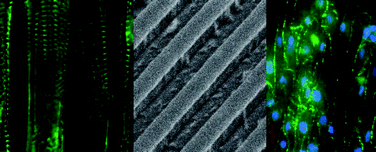Cell culture chips for simultaneous application of topographical and electrical cues enhance phenotype of cardiomyocytes†
Abstract
In vivo, cardiomyocytes are exposed to multiple biochemical and physical cues including topographical and electrical cues. During prolonged in vitro cultivation in standard tissue culture set-ups, cardiomyocytes are known to de-differentiate due to the lack of appropriate micro-environmental cues. Most currently available cell culture systems provide only a single biophysical cue, thus development of advanced cell cultivation systems incorporating multiple cues is urgently needed. We report here the development of a microfabricated system, incorporating topographical and electrical cues on a single chip, which enables cultivation of differentiated cardiomyocytes. The cell culture chips were created by hot embossing of polystyrene, to create microgrooves and microridges of precisely defined depth, width and periodicity. Substrates consisting of 0.5 µm-wide grooves and 0.5 µm-wide ridges (1 µm period) and those consisting of 3 µm-wide grooves and 1 µm-wide ridges (4 µm period) were investigated, with smooth surfaces used as controls. The depth of the microgrooves was 400 nm. The two gold electrodes were electrodeposited 1 cm apart such that the microgrooves in-between were oriented either parallel or perpendicular to the electrodes, enabling studies of interaction between topographical and electrical cues. Neonatal rat cardiomyocytes cultivated on microgrooved substrates for 7 days were elongated and aligned along the microgrooves forming a well developed contractile apparatus, as evidenced by sarcomeric α-actinin staining, with a more pronounced effect on substrates with 1µm compared to 4 µm periodicity. Importantly, simultaneous application of biphasic electrical pulses and topographical cues resulted in gap junctions confined to the cell-cell end junctions rather than the punctate distribution found in neonatal cells. Electrical field stimulation further enhanced cardiomyocyte elongation when microgrooves were oriented parallel to the electric field. Due to the compatibility of the described cell culture chips with fluorescence and


 Please wait while we load your content...
Please wait while we load your content...